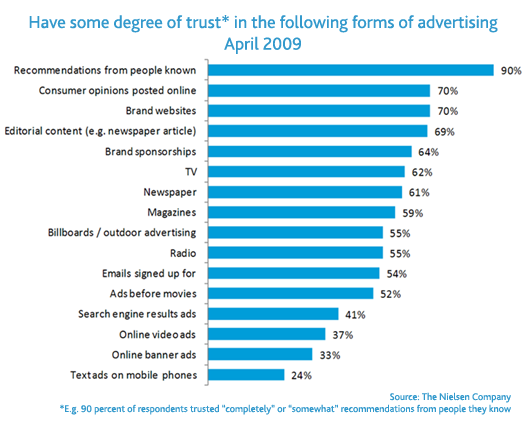Marcia Conner's Blog, page 4
March 28, 2013
Tools I Use

Yesterday I participated in two fabulous webinars, each with a different focus, yet both with social learning themes. During each I was asked about some of the tools I use personally to get the most from social media–and ultimately learn as much as I can. Because the names flew by fast, here’s a recap of the tools that I use personally and some additions I didn’t have a chance to mention.
[I've made bold links to the primary social tools that I use. The other links are either not quite as popular or they are tools supporting those main ones.]
Twitter - A commercially available microsharing tool full of short bursts of information allowing you to learn quickly from people around the globe. Take a look at my primary twitter account @marciamarcia if you’d like to see how I use twitter to share and learn from others. Also take a look at some of the lists I’ve created to more closely listen to groups and topics.
Bit.ly – A link shortening tool that also allows you to track the popularity of the links you share. The links you generated with this tool can be used anywhere online, not just Twitter.
Buffer – Providing an easy way to share tweets (or status updates to most every social network) by allowing you to choose set times to post each day. Mobile and desktop versions available.
Tweetchat – Aggregation tool for following a specific hashtag during an event or Twitter chat. (Here’s a list of all the regularly schedule twitter chats going on in the world.)
TweetCaster - Mobile client for Twitter that allows me to manage several different twitter accounts at the same time from my smartphone. Although I often use the Twitter client for Android too, at times I want to tweet from one of my other accounts (for example, @newsociallearn) and this tool makes the process easy.
Socialbro – Feature-rich tool for analyzing those you follow (or who follow you) on Twitter, telling you for instance when most of them are online and are most likely to see your tweets.
Grabinbox – I love quotations and sprinkle them into my tweetstream throughout the day. I use this nifty tool to create a running queue of quotations that “drip” into my stream over time no matter what I’ve posted directly or through Buffer. The creators of this tool also created JustUnFollow.
In addition to Twitter, I also use Socialtext Signals, Socialcast, and Yammer with different organizations I work with. These are microsharing tools specifically designed to be used with specific groups of people, for instance a company or a team that shares a email domain name (that second part of the email address such as @marciaconner.com) or people attending a conference.
Facebook – The largest social network on the planet, with more members (901M in April 2012) than the population of Europe, Russia, and the Middle East combined (780M). I wrote a post several years ago called “Face to Facebook Learning“ challenging the notion you can’t learn on Facebook. I learn from it every day!
Google+ (also known as G+) – Google’s multilingual social network. In addition to an activity stream, similar to Twitter or Facebook, G+ also offers Hangouts which are easy-to-set-up video chats that can be recorded and posted on the web and G+ Communities that are groups requiring permission from the group owner to join. I belong to a community focused on educators using G+ hangouts in their classrooms. As soon as Buffer supports posting to G+, I’l likely begun using it more in my routine. After all I’ve loved the hangouts I’ve been a part of because they have a very personal connection feel to them and often find terrific information when I wade into my circles.
LinkedIn – A social network dedicated specifically to work connections, I participate in several LinkedIn groups and often look up people’s online resumes prior to meeting with them in person or corresponding with them online. I also find it to be an invaluable tool to find who in my own social network might be able to connect me with people I’m interested in contacting and because I have a large network, people often reach out to me because they see I know someone and want me to make an introduction. All you need is my email address (found in many places on this site) to invite me to connect with you on LinkedIn.
Pinterest - (pronounced to rhyme with Interest) This visually compelling social network features images from the web collected on bulletin-board style. I maintain boards on subjects ranging from professional topics like Social Media How Tos and Collaborative Work to more personal collections on amazing Lego creations and Ingenious Designs.
IFTTT – Standing for “If This, Then That” this is my favorite tool to manage and automate activities across all the social tools that I use. For instance, I have a recipe (an automated script that was super simple to create) that appends a note to my Evernote account each time I shorten a link in Bit.ly, reminding me later what I’ve posted and how it was shortened. Another recipe creates a bookmark on Delicious whenever I post a link through Buffer to Twitter, LinkedIn, or Facebook. Another reposts my Instagram pictures to Flickr. The possibilities are endless.
Instagram – A media sharing social network, used primarily on smart phones, provides special effects you can apply to photos to make them look terrific. Because Instagram links with 4Square and other social tools, you can also check into the location where you’re taking the picture and post your photos to other social sites. Although today you can only post pictures through a mobile phone, you can now view photos on a desktop if you know the link address to that photo.
Slideshare – A media sharing social network for distributing, viewing, and downloading presentations. You can see there my slide decks for the two webinars yesterday. They were for ON24VLE “If Social Learning is the Answer, What’s the Question?” and NASSP13, “Everything You Want to Know About Social Media But Didn’t Know Who to Ask.”
Learni.st - Curated collections of text, images, video and audio, to help you learn almost anything. I find it a terrific place to learn and create boards focused on topics such as new technology that will influence learning in years ahead called LearningNext. Another board (called LearningNow) focused on all of the online courses available today, mostly without charge.
Foursquare - A location-based social network for people with smartphones. You check into venues to share with your network what you’re doing and perhaps run into people you know. Because of Foursquare I’ve been able to see friends in airports around the world who I wouldn’t have known were nearby. The network also has some gamification features, awarding badges for people who check in frequently to places. I use it primarily to keep a running log of where I’ve been, providing especially useful to remember the names of really good restaurants and even what friends thought were the best dishes.
YouTube – The video sharing website which now also hosts live events. While I find this site full of terrific educational resources, over the past few days I changed my YouTube channel (now found at MarciaConnerTube, as cheesy as that sounds) and wanted to pull all my hair out for how unintuitive the process was. I’ll chalk it up to being older than their primary demographic… or something.
Feedly – With the closing soon of Google Reader, I’ve begun using Feedly as an RSS reader, automating how I can easily keep track of posts on my favorite blogs. I’m sorry it took so long to try out this site which is very intuitive, beautifully designed, and as terrific on smartphones as on the web.
Google Talk (GTalk) – This txting tool is as easy to use on my smartphone as through the gmail.com interface. Although I used to use Skype exclusively for quick chats, I find myself using GTalk more and more.
WordPress.org – My favorite blog platform. I use the version of WordPress than needs to be hosted on a website. I’ve also used and liked WordPress.com, which doesn’t require you to have your own dedicated website.
Flickr Search - This photo sharing website can be searched specifically for images with Creative Commons license so you can share the images across social sites. I use this search to find terrific photos to compliment my blog posts and presentations. Without a doubt, my favorite photographer who posts photos with a CC license is Thomas Hawk (also ThomasHawk.com).
Lastpass – Password safekeeping site I use to keep track of my logins for all of these tools!
As if this list weren’t long enough, I also use About.me, Scoop.it, Sonora, Dropbox, Pulse, and more. As I think of others, I’ll add links here or in the comments.
[Image: CC image by Kathleen Donovan, Social Media Heart Collage]







January 9, 2013
Resolution: This Year Create a Stronger, Smarter Organization

With this new year, you may be looking frantically for a new way to improve your organization’s competitiveness, talent, staying power, and smarts. You’re not alone.
When senior leaders of a giant materials manufacturer realized their people were not innovating as quickly as the market demanded–and slower than competitors–they assumed replacing several hundred people was a logical next step. They brought me in to reimagine their recruiting, talent management, and leadership development program. They anticipated needing dramatically different approaches than those they’d relied on for almost a century. Before we started, I spent time learning about their organizational culture, wanting to ensure new team members would be able to excel where the old team could not.
Although we spent a month assessing capabilities and gaps, a learning culture audit proved to be the most effective lever. Developed almost a decade ago, as part of writing my book Creating a Learning Culture, the straightforward model proved invaluable. We quickly learned their approach to leadership and sharing knowledge was unraveling the company’s success. “Oh,” said the head of technical strategy, “being so confident in our plans, we’re stifling how our employees work.” “Yes, and,” I replied, “this isn’t just an employee problem. The leadership team probably isn’t readying itself for what’s next.”
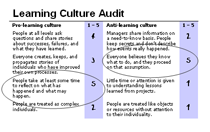 Organizational culture is one of many places where learning does not equal training. A learning sensibility (coupled with applying the right lessons fast) is the core competency that separates successful companies from those struggling to survive. When people are learning all they need and helping one another learn fast, they can make smart decisions and adapt quickly to constant change.
Organizational culture is one of many places where learning does not equal training. A learning sensibility (coupled with applying the right lessons fast) is the core competency that separates successful companies from those struggling to survive. When people are learning all they need and helping one another learn fast, they can make smart decisions and adapt quickly to constant change.
In this corporation’s case, they had the people they needed. They had a workforce of bright, creative people eager to solve problems in new ways. They just also had endless obstacles in people’s paths stopping people from doing what needed to be done. By breaking long-standing patterns and clearing away the practices that seemed like good ideas when they were launched, but together were maddening, we ended up reinventing their people strategy for their existing workforce, people desperate to work in new ways.
Conducting a simple learning culture audit can help you assess your organization and your leadership team’s orientation to continuously learn and apply what they’re learning. Examining the characteristics of cultures that encourage or block learning provide a way to see how well you’re fostering an environment where people glean new insights and get stronger now.
Consider each question carefully. Think about your behavior and that of your colleagues. You might also want employees to complete such a survey to get a sense of how they perceive you and the entire organization are doing.
By taking your organization through this audit, you demonstrate your willingness to ask tough questions and hear answers that are honest rather than reassuring. The self-assessment should take no more than 10 minutes and the lessons learned can focus your organization for at least the next year.
Instructions: Rank your organization on each characteristic along a scale of 1 to 5, 1 being always no and 5 being always yes. At the bottom, tally the rankings to determine if your organization has more of a pro-learning or an anti-learning culture. Circle the items in each category that require special attention from you in the coming days, weeks, and year.
Pro-learning culture
1–5
Anti-learning culture
1–5
People at all levels ask questions and share stories about successes, failures, and what they have learned.
Managers share information on a need-to-know basis. People keep secrets
and don’t describe how events really happened.
Everyone creates, keeps, and propagates stories of colleagues who have improved their own processes.
Everyone believes they know what to do, and they proceed on that assumption.
People take time regularly to reflect on what has happened and what may happen.
Little time or attention is given to understanding lessons learned from
projects.
People are treated as complex individuals.
People are treated like objects or resources without attention to their
individuality.
Managers encourage continuous experimentation.
Employees proceed with work only when they feel certain of the outcome.
People are hired and promoted on the basis of their capacity for learning and adapting to new situations.
People are hired and promoted on the basis of their technical expertise
as demonstrated by credentials.
Performance reviews include and pay attention to what people have learned.
Performance reviews focus almost exclusively on what people have done.
Senior managers participate in training programs designed for new or high-potential employees.
Senior managers only kick off management training programs, rarely facilitating conversations or courses.
Senior managers are willing to explore their underlying values, assumptions, beliefs, and expectations.
Senior managers are defensive and unwilling to explore their underlying
values, assumptions, beliefs, and expectations.
Conversations in management meetings constantly explore the values, assumptions, beliefs, and expectations underlying proposals and
problems.
Conversations tend to move quickly to blaming and scapegoating with little attention to the process that led to a problem or how to avoid it in the future.
Customer feedback is solicited, actively examined, and included in the next operational or planning cycle.
Customer feedback is not solicited and is often ignored when it comes in
over the transom.
Managers presume that energy comes in large part from learning and growing.
Managers presume that employee energy comes from corporate success and profits.
Managers think about their interest in and capacity for learning new things (their learning quotient), and the learning quotient of their employees.
Managers think that they personally know all they need to know and that their employees do not have the capacity to learn much than they know.
Total for pro-learning culture
Total for anti-learning culture
The column with the highest total represents the type of culture you have today.
If you’re interested in distributing a copy of this assessment to the people you work with, download a copy at http://j.mp/LCAprint. More, much more, on creating a learning culture can be found in my article “Create a Learning Culture“ (Fast Company online resource center) and the book Creating a Learning Culture: Strategy, Technology, and Practice (Cambridge, UK; Cambridge University Press, 2004). If you sign up for my blog updates, you’ll be notified when I post blocks of text from that book to this site in the coming weeks. In the meantime, you can read the first chapter by Harlan Cleveland.
Happy New Year.
[Image: CC image by ThomasHawk, Fireworks 4]







January 1, 2013
The Year In The Rear

Reflection isn’t just what you see in the mirror. Consider it a light that can guide what’s in front of you and a way to more carefully examine what’s behind. In that reflection you can revisit what’s happened and ready yourself for what’s next.
For me, 2012 was full of the unexpected. Time after time I was reminded of the saying, “If you want to make God laugh, tell her your plans.” Today I’m reflecting so that even if 2013 takes me on another grand prix, evidence shows I’m ready for the race. Let me share with you a bit about how the year started and what I did instead along the way.
I had intended on spending the year shoulder-to-shoulder with clients, putting an end to organizational work that sucks. Instead I had aggressive kidney-stone surgery in the spring. (All better now, thank you!) While I was on the ground for two months, we learned together that digging deeper could work from a distance. Complex transformations began over the social technologies we’d put in place. Ambient awareness allowed us to stay in step when we couldn’t sit side by side.
I had aspired to make this year the one when I’d publish more reports and articles, providing ample fodder to fill my blogs. Instead I assembled just a few key influence pieces, including the forward to Ed Brill’s new book, Opting In, and several posts on big data that went viral. I met with my favorite local newspaper journalist, Cindy Correll, to get insight on how to write faster. I honed my website’s focus so people better understood what I do. I was fully present as my son took a break from Minecraft and LEGOs to discover he likes to read. Yet there was more, and it was rough.
I had prepared to finish up my next book, about ingenuity and how to work through rather than detour around life’s challenges. Instead of completing it, I took my own counsel and dug into what was in front of me and inside me. Although I was able to write most of the chapters, I abandoned the rigid schedule of my previous books and stayed connected with my family even through many long days. By living what I was writing about, I proved to myself I really was on to something and that perhaps even if we can’t have it all, we can create what we need.
Now I need to take Cindy’s advice to stop writing before I’ve said it all. She reminded me that readers aren’t going to forget my serious writing if occasionally I post something short and personal. She reminded me sharing is an art form that needs practice as much as reflection.
Here’s to a new year where we all share less about what we’re going to do, growing instead based on action. Here’s to an unexpected, lively and joy-filled year ahead.
[Image: CC image by ThomasHawk, FlickrNation, Episode 2]







December 21, 2012
Not a bad year, just not great. Nice knowing you.

Last week imagine my surprise when a holiday card arrived from my friend Bill Owen, who passed away in early October. A bristly 80 year old, William Henry Owen IV engineered the world around him to infinity and beyond.
As we all wonder (if only a little) whether the Mayans had this one right, predicting today will be our last, I’ve been thinking about Bill’s words and insights.
For years WHO4, as he referred to himself, combed through the Financial Times pink pages, which were delivered to his Virginia door each morning before sunrise. With some regularity, an unadorned manilla envelope would then arrive in my mailbox, containing articles on topics perfectly timed to fill in details on stories I was writing or projects holding my attention. It was as if even when we hadn’t seen one another, he was drawn to what mattered to the people who cared deeply about him. Yet he just as easily could move on to what was next.
That’s how I’d like to be remembered and that’s how I’ll always remember Bill.
He exemplified a quotations from Ralph Waldo Emerson:
“Finish each day and be done with it. You have done what you could. Some blunders and absurdities no doubt crept in; forget them as soon as you can. Tomorrow is a new day; begin it well and serenely and with too high a spirit to be encumbered with your old nonsense.”
Bill missed the tragic events in Connecticut, although I feel certain he’d have provided a thoughtful comment. Perhaps the closing lines of his holiday card can at least ground us in the reality (notwithstanding his trademark sarcasm) that comes from looking back on life’s final days.
“Not a bad year, just not great. Nice knowing you.” Wm. H. Owen IV
Here’s to the sun coming up tomorrow.
[CC Image from Patrick Nouhailler, Sunrise in Geneva]







November 12, 2012
You Can Do Anything

“How many of you were told when you were young that you could grow up to be anything you set your mind on?”
A professor-friend recently opened his graduate management course with this question. Fewer than half the people in the room raised a hand.
I’ve begun asking this of everyone I meet, trying to get a sense if there’s a relationship between the mental paths paved during childhood and each person’s natural self-leadership to reach beyond obvious walls.
Similar to the class numbers, about half the people I speak with shake their head in wonderment, citing examples of a parent who regularly alluded to or directly told them opportunities were far and few.
One colleague said his parents regularly told him his options and potential were limitless, but also only set the bar knee high. They would say things like, “Your dream sounds neat but who would want to spend their whole life working that hard?” Pronouncements alone fall flat.
In my family, by contrast, my father took this question to another height, even using it as a game on long car trips. He’d ask me, “What couldn’t you do?” He did this to help me build pathways to envision I could do almost anything. Then we’d talk through the steps it might take to reach high.
One of my most creative moments came on a day when I was about ten. I said, “I couldn’t walk through the sun unassisted.” I recall brief chatter about inventing a protective suit but for the most part it ended our conversation — at least that day.
So what are you asking your children? What mental roadblocks are you helping your employees dismantle? What limits to your freedom are like mirages that once you close in on are simply reflections of something else?
Although I haven’t always succeeded, I feel accomplished… and the flops taught me so much I appreciate them, too. Walking through the sun, however, still eludes me.
——–
This post was originally on my Fast Company column.
Marcia Conner consults with the world’s largest organizations on getting better at getting better. She recently published The New Social Learning: A Guide to Transforming Organizations Through Social Media and is currently working on her next book which will be about ingenuity. Follow her at twitter.com/marciamarcia to learn more.
[Image: CC image by ThomasHawk, Beach Performances]







November 7, 2012
Social Business by the Numbers
Seeking the source of a specific statistic that I included in a talk? In followup to my list of websites with data relevant to social business, many people have asked for pointers to interesting data about social media, social business, and engagement. While it’s easy to think of social business as social media-like tools for use inside of a company, I mean it to imply the larger opportunity to connect people, information, and actionable insights. That can begin within a company, and often stretches outside any one organization’s walls to connect with the people the business serves.
My aim will be to update this list as I discover more numbers that make points better than words. New additions will be marked (new w/date). Consider bookmarking this post so you can return to it again.
IBM’s 2012 CEO Survey of 1700 CEOs across the globe [released May 2012] tells many interesting things.
Although face-to-face will remain the most prevalent form of customer interaction, CEOs expect a step-change in the use of social media. Over 1/2 expect social channels to be a primary way of engaging customers within five years.
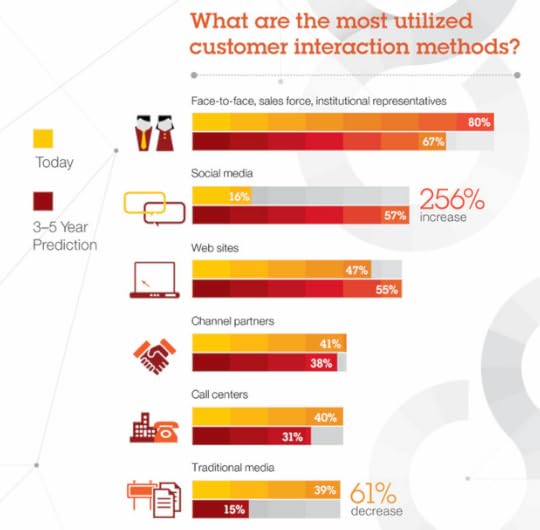 Currently, social media is the least used of all customer interaction methods. However, CEOs predict it will push past websites, call centers and channel partners, and become the #2 way to engage
Currently, social media is the least used of all customer interaction methods. However, CEOs predict it will push past websites, call centers and channel partners, and become the #2 way to engage
customers within the next five years.
73% of CEOs are making significant investments in their organizations’ ability to draw meaningful customer insights from available data.
Views on social media vary widely across industries. A higher percentage of CEOs in education (77%), telecommunications (73%) and retail (72%) expect social media to be a key channel for customer engagement. In industrial products, only 34% of CEOs believe social media will play a significant role—the lowest of all industries; insurance (51%) and electronics (52%) are below the overall average.
Also from IBM’s Institute for Business Value:
95% of standout organizations will focus more on “getting closer to the customer” over the next 5 years (IBM Global CEO Study 2010).
57% of financial outperformers are more likely than underperformers to use collaborative and social networking tools to enable global teams to work more effectively together (IBM CHRO Study 2010).
Companies with highly-engaged employees have 26% higher revenue per employee.
2% increase in customer retention has the same effect on profits as cutting costs by 10%.
There are more people on Facebook (901M) than in Europe, Russia & Middle East combined (780M).
90% of people under 30 in US are on a social network. 50% of the world population
Over 1 trillion connected intelligent devices across the world.
5 Billion mobile phone subscribers (that’s 7 in 10 adults worldwide).
In 2012, smartphone sales will outpace PC sales By 2014, pads will surpass enterprise tech purchases.
From Harvard Business Review Analytics Services and SAS in The New Conversation: Taking Social Media from Talk to Action [pdf], June 2010.
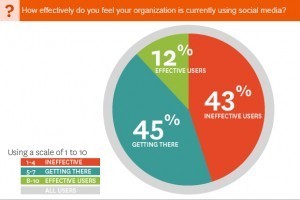
79% of companies are using or plan on using social media. 58% are using it. 21% are planning to launch something.
69% predict that their use of social media will grow, 61% admit the need to overcome a learning curve before adopting any kind of social media strategy. Just 32% view it as an executive priority.
Just 20% of social-media-using organizations have dedicated a portion of the budget to it, though that rises to 44% among effective users.
14% cite responding to findings from social media, such as quickly resolving an issue raised via one of the social sites.
13% say that finding qualified staff who can work on social media activities is a challenge.
12% of the 2,100 firms surveyed feel that they are using social media effectively, by going above and beyond the typical megaphone marketing. They are monitoring trends, promoting their brand and researching new product ideas. 43% feel they are using it ineffectively. 45% believe they are getting there.
11% believe the use of social media for business purposes is a passing fad.
Social media use among small businesses was up 8%, from 73% spring 2011. Constant Contact’s Fall 2011 Attitudes and Outlooks Survey.
About 60% of those surveyed said they respond to comments they received through social networks, whether they’re negative or positive. The 40% who aren’t regularly responding to comments said the didn’t because:
They don’t have time
They don’t think it’s necessary
They don’t know what to say
The University of Maryland’s Smith School of Business looked at the relationship between social media and small businesses and found that the technology adoption rates in the U.S. doubled from 2007-2009 from 12% to 24%.
Only 1% of Facebook Fans Engage With Brands. AdAge
97% of customers will purchase from your business based on a review they find on the product they are looking for, even more so the review is through people they trust.
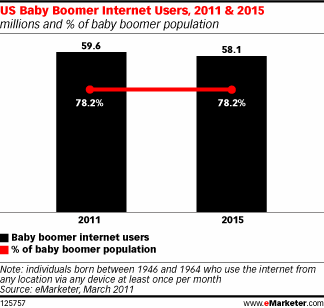 eMarketer reports that 78.2% of boomers are online and using mobile. That’s 60 million adults. Even as their numbers decline, that penetration rate will remain high through 2015. And they control more than $2 trillion in annual spending.
eMarketer reports that 78.2% of boomers are online and using mobile. That’s 60 million adults. Even as their numbers decline, that penetration rate will remain high through 2015. And they control more than $2 trillion in annual spending.
Young boomers (ages 47 to 55) spent an average of 39.3 hours online per month in 2010, according to the Pew Internet & American Life Project. Older boomers (ages 56 to 65) averaged only slightly less, at 36.5 hours.
Boomers also stay connected on the go. eMarketer estimates 86.9% will have a mobile phone this year, and 16.9 million boomers will access the internet from a mobile browser or installed app. In 2015, that number will reach 25.4 million, or nearly 40% of boomer mobile users. This is a market that content providers, game publishers and brand marketers should not pass by.
90% of online consumers trust recommendations from people they know; 70% trust unknown users, 27% trust experts, 14% trust advertising, 8% trust celebrities. Nielson Global Online Survey, July 2009, referenced in Erik Qualman’s Socialnomics. More on personal recommendations:
92% have more confidence in info found online than they do in anything from a salesclerk or other source Wall Street Journal, Jan 2009
75% of people don’t believe that companies tell the truth in advertisements. Yankelovich Consumer Report, 2010
70% consult reviews or ratings before purchasing. BusinessWeek, Oct. 2008
7 in 10 who read reviews share them with friends, family & colleagues thus amplifying their impact. Deloitte & Touche, Sept. 2007
Why do they share? 46% feel they can be brutally honest on the Internet. 38% aim to influence others when they express their preferences online Harris Poll, April 2010
45% say they are influenced a fair amount or a great deal by reviews on social sites from people they follow with 46% saying that reviews in newspaper or magazine influence them. Harris Poll, April 2010
43% of us will seek advice from a friend, family member or colleague before making a purchase. GfK MRI, June 2010
34% have turned to social media to air their feelings about a company. 26% to express dissatisfaction, 23% to share companies or products they like. Harris Poll, April 2010
Reviews on a site can boost conversion 20%. Bazaarvoice
From GfK MRI, June 2010: % Twitter users are more likely than total adults to:
Write a Blog – 506%
Join environmental groups/causes – 142%
Join groups that influence policy or government – 141%
Bazaarvoice, in their Conversation Indexes provide some terrific gender-related stats related to social business.
The Conversation Index Vol. 1 (September 2011)
Women produce 60% of all user-generated content.
Women are more positive reviewers than men. The average rating for female-written reviews was 4.43 out of 5, as compared to the male average of 4.32.
The Conversation Index Vol. 3 (March 2012)
Women who buy something in a store rate it four to five stars (out of five) 87% of the time. Men who make a purchase in a store only assign four or five stars to products 80 percent of the time. Research underscores that men find online shopping an effective way to avoid the hassle of in-store shopping.
75% of women say ads on social networks don’t encourage them to purchase. (from Media Post News, September 2009)
—-
In addition to continuing to update this page over time, I’ve also created a Scoop.it page focused on Data on our Social World. Consider following that page for regular updates, infographics and various things I find.
If you have favorite stats or sources of stats on this theme, please send them my way and I’ll include in future updates. Together we are better. The stats prove it.







October 8, 2012
May I Borrow Your Job?

A local government in Virginia had the same leadership development and talent challenges as any large organization. They faced knowledge gaps, communication breakdowns, lack of succession planning, job burnout, too few qualified applicants and had an interest in keeping HR lean. Then the County Administrator, a county’s CEO, tried something radical. He removed policies making it difficult to change jobs and he actively encouraged employees to seek change.
A groundskeeper went to work in accounting. The purchasing director took a turn as budget manager during the peak budget season. The senior planner, who usually had the last word on other people’s projects, navigated a major renovation project through the very same system. What started as a part-time, short-term internship program evolved into a full range of real-time learning experiences giving people already in the door solid opportunity to discover their best work.
An endless combination of special projects, committee assignments, internships, job shadows and stair-step swaps provides people variety and broadens their professional experience. From these exchanges people gain insight larger than any single job offers. Upon return, they inevitably interject fresh views into their existing departments. Some people also find better jobs, giving someone else a chance to grow into the job they had.
These assignments don’t just happen in the trenches. They occur in every department. Assignments are often geared to strengthen the county’s leadership team, involve managing multimillion dollar capital improvement or construction projects, working with public officials, and serving on regional boards. The County Administrator strongly encourages rising leaders and their seconds to move around, learn, and stretch. Posts that cross departments usually get his personal attention as he helps determine placement and key project assignments.
Seventy percent of senior leaders have participated so far, and of the remaining 30 percent their seconds have participated. Assignments and cross-posts last six months and usually emerge during key cycles, during the busiest part of the year: October through April, when everyone is working on budgeting and people are guaranteed to learn (and help) the most.
How Does the Program Work?
From the moment you join the organization, you’re encouraged to grow and develop. At new employee orientation, the County Administrator tells you the new employee that you have two responsibilities: to do your job and to develop to your fullest potential.
The county offers training sessions and resources such as a workshop called “Promoting Yourself” which includes mock interviews conducted by hiring supervisors. The practice bolsters confidence and regularly results in well-deserved promotions.
When there is a vacancy or an employee is on extended leave, the first question asked is “Is this a learning and developmental opportunity for one of our employees?”
Intra-department exchanges don’t require any outside assistance and now, managers know they have authority to make local changes as they see fit.
There is a proactive element from the county, too. Natural leaders are often busy doing their jobs, sometimes the last ones to think, “Perhaps I need a change.” As part of human resource planning, when a big project or critical job opens up, the people in HR get nosy. They go to managers and say, “Hmmm would this be a good opportunity to offer a special assignment or to stretch someone’s skills?”
The program has been formally going on for five years, and by all measures it’s a great success. Participants rate the experience as positive by every measure.
How Long Do Exchanges Last? What About Pay?
Most exchanges are full-time and last six months. Employees don’t get a pay change unless they’re in the new role for more than six months (and then only the extension-pay adjusts). This is a development opportunity, but they also don’t want to take advantage of the situation or give the impression that participation in the job swap ensures a permanent move to the new role. It’s an exception for an assignment to go more than six months.
Who Does the Job Back Home?
Sometimes people who take on assignments don’t have their current job backfilled. Other times someone else from the organization moves up (or over). For instance, in the Water and Sewer department, a manager took on a key assignment and two engineers from the department took over his key duties. The county offers to pay for a temp to fill in for the least skilled position vacated by a stair-step change, although so far no one has taken the offer.
In HR, after two employees stair stepped into new roles within the departments, someone from a less busy department moved over to fill some clerical duties and sharpen her computer skills. She also learned about the hiring process. When she went back she streamlined the hiring process in her existing parks and recreation departments’ after school programs.
Do All Assignments Lead to Promotions?
About 30 percent of exchanges have led to promotions or permanent changes within the organization and about 10 percent have left their department for other opportunities. Most returned to their previous positions, in part, because of the limited number of executive vacancies. A change in position doesn’t always turn out as a person might expect: it might just be to help someone see their ideal job isn’t a good fit.
Logistics also play a big factor. With only eight executive positions, promotions at the top can be frustrating. The county hasn’t seen anyone get exasperated and leave, though. People still feel engaged and they can get big assignments. If not a new title, they gain confidence in themselves. What more can you ask for than employee engagement and retaining the best?
There are other benefits, too.
Walk a Mile, Gain Perspective
Rarely does everyone appreciate the work done by those around them, not even those they work with closely. Swapping jobs with someone else gives people day-in day-out experience with another angle. This new perspective helps people fundamentally adjust their usual work to accommodate the larger view.
Take for instance an exchange in the police department. Before this program began, a uniformed officer discovered a crime and then turned it over to a police investigator. Acting independently, even in a single department, hampered investigations. Instead of creating laborious procedures not guaranteed to work, the police chiefs of the two divisions swapped their positions for a year.
By walking and driving miles in another’s shoes, crime investigating improved tenfold. Officers saw gaps in their working knowledge and surfaced unanticipated assumptions that had limited their capacity to learn. From the exchanges, everyone reported they saw their roles in new ways and were more effective at stopping crime.
Float It Elsewhere
What happens in your organization when employees can’t find their groove? Maybe they won’t fit anywhere. More likely, their assets just don’t match job. Other open positions might allow them to soar.
Take the case of the custodian deemed to be doing a crappy job. In his evaluation, it was also noted he was great at talking with people. The department and HR discussed options to probation. His supervisor was thrilled to have a chance to, even temporarily, backfill his job with someone else and the custodian welcomed the chance to prove he was a good fit in another department. After six months he was moved permanently into social services where he began training to become a case-aide. Now he’s a successful, happy, and helpful social worker. All this from doing a poor job.
Dig for Talent
Employees who hold low-level positions can find themselves bored, and a bored employee is more likely to under-perform, or even look for new work. A job swap can breathe new life into a person’s work day. Consider closing critical positions with people in other departments whose jobs wouldn’t be as tricky to backfill.
During a crucial budgeting season, the county couldn’t fill accounting jobs fast enough. The supervisor listed the foundation skills needed for the position and the HR team went to work seeing if they could find people in-house. Within a week, they found two qualified people voicing interest in an exchange. One was in grounds maintenance and the other was running after-school programs. Each was brought in for six months. One liked the new role and eventually took it full-time. The other hated the job, realizing he never wanted to work in accounting again. However, the people he worked with were impressed with his initiative to step outside his previous role and it eventually lead to a new job better suited for him.
If for No Other Reason
Sometimes life events cause great employees to ask, “What else could I do?” Injury, illness, a move, needing to be home more with family, or any number of personal changes mean someone can no longer fulfill his or her job. The county is committed to their employees — after all, they are also their county citizens, and they have found the exchange program approach helps meet everyone’s needs. It’s now part of their culture, it’s how they work. They haven’t seen any decrease in productivity and they have seen a huge increase in retention rates.
Extensive surveys with departments and people involved in the exchange program show it far exceeds people’s expectations. No one seems to mind small disruptions in productivity when everyone has a chance to learn and grow. More than 90 percent rated the experience as positive also citing a strong interest in continuing to work for an employer committed to providing transformative opportunities.
Perhaps nothing illustrates the success of the program better though, than the experience of the County Administrator who was out of town during a Category I hurricane. Rather than return home immediately, he stayed put. He knew there was a cadre of people who could step in to fill his responsibilities and then people to fill theirs. They weren’t just acting like they knew what to do: they knew what to do because they’d done it before.
—
This post was originally on my Fast Company column.
Marcia Conner consults with the world’s largest organizations on getting better at getting better. She recently published The New Social Learning: A Guide to Transforming Organizations Through Social Media and is currently working on her next book which will be about ingenuity. Follow her at twitter.com/marciamarcia to get a sense of what she’s learning with people in all sorts of jobs.
[Image: Flickr user Andyi]







October 4, 2012
Defining Social Learning
Two years after we published The New Social Learning, I still hear people say “there is no definition” or worse yet, defining it in truly silly ways. A post with a slide of my definition is consistently one of the most popular posts on this site so I thought people might appreciate more on how I define the terms and what social learning is not. I’ll frame this in the questions I’m often asked.
How do you define social learning?
I define social learning as participating with others to make sense of new ideas. Augmented by a new slew of social tools, people can gather information and gain new context from people across the globe and around the clock as easily as they could from those they work beside.
“Social learning is not just the technology of social media, although it makes use of it. It is not merely the ability to express yourself in a group of opt-in friends. Social learning combines social media tools with a shift in the corporate culture, a shift that encourages ongoing knowledge transfer and connects people in ways that make learning a joy.” Excerpt from Where Social Learning Thrives (an article I wrote with Steve LeBlanc originally posted on Fast Company’s site).
What isn’t social learning?
Social learning is not technology. Re-read especially the first sentence above: it’s a very human way people have communicated throughout our history.
It’s not synonymous with informal learning, a term often used to describe anything that’s not learned in a formal program or class. The broad category of informal learning can include learning socially, but some instances of informal learning are not social—for example, search and reading.
It’s not a new interface for online search, which could only be considered social because other people developed the content you discover. Finding content with a search engine does not involve interpersonal engagement—a hallmark of social learning.
It’s not the same as e-learning, the term used to describe any use of technology to teach something intentionally. That broad category can include social tools and, if it’s organized using an online learning community, can be quite communal.
It’s not constantly social in the same way a party is. Often people are alone when they are engaged and learning through social tools. The socialness refers to the way interaction happens: intermingling ideas, information, and experiences, resulting in something more potent than any individual contribution.
What do you see as the impact of social technology on learning?
Learning can easily occur anytime, anywhere, and in a variety of formats. It always has, but augmented by social tools, now it’s easy for others to see and learn from too.
Social tools can enable organizations to strike a balance between surfacing the knowledge people need and giving them the ease and freedom to learn in a healthy and open way.
We look across the tweet stream and tuck away lessons of finessed customer service calls, graceful endings to overlong presentations, and recoveries from cultural faux pas in front of visiting clients. Together we are better. Together we participate with others and learn nonstop.
Why hasn’t social learning become a mainstay of corporate learning?
Let’s not mix up learning with the assistance of social technology and learning socially. This question implies people aren’t using social media to learn. I think we could all agree almost everything in organizations is learned with other people, even if not across social tools. And if you believe people aren’t using social tools to learn, look closer. They may not be learning what you want them to learn but people are constantly learning what they want to online, be it what their friends and families are up to or what people that influence them are doing right now.
How do you personally use social technology to learn and grow?
Every day I connect and learn from people across the world through social technologies. Some of these people I’ve met in person, increasingly they are people I didn’t know before social media. From them I glean new insights about topics I set out to learn as well as get introduced to new topics and related information I didn’t realize would help round out what’s important to my life and in my work.
What advice do you have for someone trying to incorporate social technology into their work and how people think about learning at their company?
Get clear on how you personally feel about social media. If you can’t imagine why anyone would want to read an update from you, ask a few people. Reflect on the types of things you enjoy gleaning from others. Consider intentionally finding and sharing information that sparked your interest. If you have doubts about the tools and their value, those you’re working with will sense your inauthenticness. Perhaps there are things you can learn from yourself through this reflection. Use it as a time to improve yourself.
Then get started. Find work that you find lackluster but have to do anyway, and challenge yourself to create a way to do it with other people across the social transom. Taking that step will also teach you so much. Like walking, it might require tripping a few times and getting back up, stronger the next time before you can run. There are many of us out here, happy to help, ready to welcome you with open arms in exchange for giving us the opportunity to learn from you too.
What are the silliest things said about social learning?
Instead let me list 10 Things Said About Social Learning
… that you shouldn’t fall for.
1. Social learning is new.
2. Social learning requires digital tools.
3. Social learning needs social learning policies.
4. There’s not data to support social learning, and no way to show ROI.
5. It’s always informal (or never informal).
6. A vendor can sell you social learning.
7. Social learning only works for white-collar workers.
8. L&D needs to initiate a social learning program before the organization learns socially.
9. For social learning to provide value you need a new LMS. Or an upgrade. Or an LMS at all.
10. Social learning doesn’t effect you.
What else would you like answered? I’ll do my best to answer in the comments or in subsequent posts.
—-
Related post you may find useful:
Kindle Highlights Social Learning shows you the most highlighted quotes from book, The New Social Learning
Information about the book including Chapter Summaries and how to download a free sample of the book (Forward, Introduction, and Chapter one where there is more definitional detail)
Social Media for Training with a nod to Jane Bozarth’s terrific book Social Media for Trainers
[Image: Flickr user opensourceway]







September 21, 2012
Latest in Learning Fast: edu-Twittering
A decade ago the hot app on everyone’s desktop was PointCast, a personalized headline service of content emblazoned across your screensaver through a pre-RSS feed. No typing required, no link to click through. While on the phone or talking with a colleague at your desk you could glean the day’s hot news or gather learning-bites you subscribed to receive. Downtime be damned.
Before overloading corporate servers and attention spans, it catalyzed an international conversation about new ways to deliver information and help people learn. A little push, a little pull.
Twit ahead to today, and hyper-connected status updates fill the tiny spaces in our days like expanding foam sealant.
Why not augment the question, “What Are You Doing?” with “What Are You Learning?” or even “What Can Others Learn From?”
Imagine the potential for discovery if the people who you follow through Twitter or any social-network status updates rounded out their contributions with something educational. Learning would zing wild and flow free.
Here’s how you can help.
1. Add news-to-use. If you micromessage personal feelings ala “… is feeling lazy tonight,” add something for the rest of us like, “Pizza at BestPitza on Sole Rd saved the night.” Even 1000 miles away, I might tuck away the tip and think to myself, “Lazy and clever” rather than “Lazy and wasting my time.”
2. Provoke us. Howard Rheingold recently wrote and linked, “Excessive texting may signal mental illness.” I enjoyed seeing what Howard’s reads, and the article itself reframed my thinking about IM.
3. Promote something special. Two films on my go-see list came from recommendations by people who I rarely talk with about movies. One post said, “Saw Making Trouble tonight. Good film, well done.”
4. Inspire us. An amazing friend uses her lines for gems like, “…is choosing conviction over convenience.” She seminds me to sit up a bit straighter and do the hard work.
5. Ask for advice. I recently saw this plea for assistance. “looking for a great job. mine’s a dud. if you know something I should pursue, tell me quickly.”
Let’s just avoid calling it twLearning.
I challenge everyone who reads this to try edu-twittering for a week. Tell us here you’re on board. We’ll learn together what happens.
—–
This post was originally my April 2008 Fast Company column. It seems as relevant today as it was back then. It’s never too late to take the edu-twittering challenge.
Scott McLoed inspired me to revisit this article after I read his terrific post, “If You Were on Twitter.”
—–
Marcia Conner consults with the world’s largest organizations on getting better at getting better. She recently published The New Social Learning: A Guide to Transforming Organizations Through Social Media. Follow her at twitter.com/marciamarcia to get a sense of what she’s learning and what she’s learning from others both on Twitter and around the globe.
[Image: Flickr user spaceamoeba]







September 10, 2012
Get on the road this September 11th

One summer day, when I was a kid, my childhood neighbor Tim ran through a plate glass door. He required thousands of stitches and lengthy recoup time. Though he mended, none of us was the same.
The summers following his recovery were different from those before, now knowing firsthand one action can change existence. This was most noticeable in the middle of the road.
When running and playing on our small cul-de-sac, we looked up and around more than ever before. If we heard a car, even in the far off distance, we moved to the side. We readied ourselves for even the possibility of danger by getting out of the way.
Glued to the sideline, we were often apart from one another. Unable to make plans. Frozen in time. Standing still instead of playing. In response to one bygone danger, we became apprehensive to all that were possible. We ceased readying ourselves for a full life ahead.
Eleven years after 9/11 (and four years after an economic collapse), many organizations stand beside the road. Even people with stable jobs struggle to find meaning at work. Some see potential, but move out of harm’s way, missing the action and the opportunity afforded only those still on the road.
To make connections that change and improve our situation, we need to participate, take chances, and be in the place of most potential—together, making plans, and with a sense of play.
Without being actively in the fray, we miss the opportunity, the serendipity, and the providence that can make work purposeful, profitable, and interesting.
To become strong, to be whole, we need to continue looking up, and also to move toward readiness instead of away from the action ahead.
Once we can lean into our fear we can stand strong in the middle of the road, be ready to move, and then move in the right direction—together.
Let’s agree to acknowledge our fears and our apprehensions, but also to live our lives. Ready?
[Photo credit: Blur, drp]








